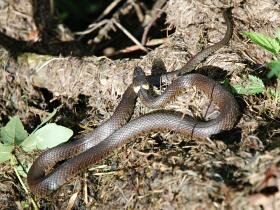|
Mention must be made of snakes. There are snakes in Corfu as in almost any other country (excepting Ireland of course) and dead ones are often seen on the roads.
There are several harmless species of snake and one poisonous. If you happen to see one, and the majority of visitors don't, the usual view is a fast disappearing tail into the undergrowth. Some get caught under the nets laid on the ground under the olive trees and panic to get away.
Often seen is the harmless Grass Snake or Ringed Snake, identified by the yellow patches (ring) on the neck and general olive coloured body.

Grass Snake.
There is one poisonous species, a type of viper quite similar to the British adder, but the poison is more virulent.
The Nose-horned Viper is a relatively small snake less than a metre long and very shy. It has an upward pointing stump on the end of its nose but if you are close enough to notice that you are TOO CLOSE! It can strike a long way ! This viper is possibly Europes most deadly snake, but will avoid trouble with people as much as it can. It is placid by nature and will normally only hiss, and almost all bites occur when the victim is trying to kill the snake or photograph it. The Viper does not want to encounter people and will try its hardest to avoid detection. It will normally be long gone before you arrive, being warned by the your footstep vibrations. Most of these vipers are about 2/3 of a metre long with a quite chunky body and usually a thick dark zig-zag stripe the length of its body along its back, with dark blotches on its sides. Locals dispatch them to the next world immediately.
A snake which can be fairly similar in colouring and size to the viper and often seen dead on the road is the Dice Snake. (NOTE: It is also 'plays dead' at times and can give a nasty surprise when it suddenly comes to life ! )This is a bit longer (about a metre plus) and slimmer than the viper. The Dice Snake is non-venomous and harmless but its similar background colouring and blotchy markings often commit it to the same fate as its poisonous comrade. It favours damp areas close to water and often feeds on small fish, frogs etc.
For comparison a Nose-horned Viper and Dice Snake are shown side by side so the distinctive strong dark markings.

Nose-horned Viper (venomous)
|
|

Dice Snake (harmless)
|
| Warning: Both snakes come in wide colour variations |
The unusual 'nose' giving the viper its name is a 'stump' of scales. This is a certain identification but at some angles is difficult to see and the snake's head is very small anyway so do not rely on it, unless the reptile is dead.
 |
One of the 2 large snakes in Corfu is the harmless Four-lined Snake , a type of ratsnake, which can grow to almost 2 metres. In 15 years of walking in the Corfu countryside the writer finally saw one of these in May 2008. It was lying on a farm track as if dead but soon slid away into the undergrowth. A good 1 and 3/4 metres long it was the thickness which was surprising, at least as thick as a man's wrist.

Four-lined Snake
The other large snake is the Montpellier which grows about the same size but is slightly poisonous and can be agressive in that it rears up and hisses. As its venom fangs are set at the back of the mouth it is unlikely to cause problems for humans. In the unlikely event of being bitten the result would be extremely painful but not dangerous for most individuals.
|